Cheers to you, higher ed social media pro: you may not realize it, but you’re at the epicenter of the social media marketing revolution.
For the better part of a decade, we have heard of social media’s great marketing power and seen the rise of social platforms and their unavoidable daily presence. Despite the promise, significant swaths of corporate America still view social media with a certain distrust.
Higher Ed Leading in Social Marketing
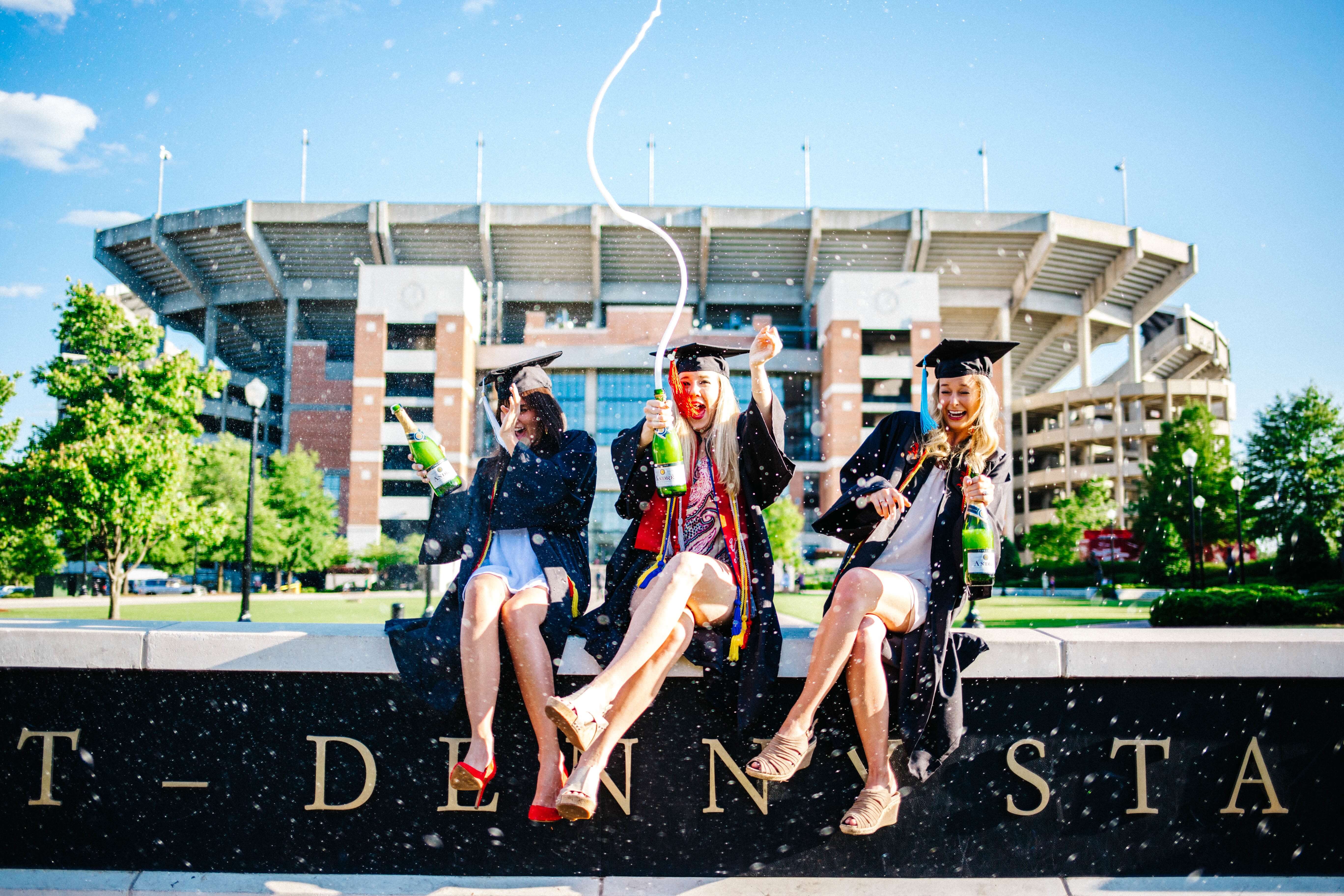
Higher education, however, is embracing social media, and rightly so given their audiences’ demographics. Reliance on social media is well-established by young people. Less frequently addressed is the power of emotion that colleges and universities have harnessed to engage with their audience at a rate that makes other industries green with envy. The depth of engagement in higher ed is like nothing else.
I grew up on a campus. My father was a political science professor. From my earliest days, I understood the special appeal of a university campus; an understanding magnified when I arrived at college as a student.
For a higher ed social marketer, a powerful tool for creating engagement with your audience is contained in the history and experience of your campus and what it represents. Much of what links us to our alma maters is outside the classroom. You have an exceptional opportunity to engage with your audience through these shared emotional experiences.
The following recommendations come from analyzing thousands of social posts from hundreds of higher education institutions, as well as my own decades of marketing experience and the belief that the most valuable social engagement comes down to the emotional connection with your audience.
1. Use images
Sometimes when I tell people about the importance of imagery in social media, they roll their eyes like it’s the most obvious thing. After looking at thousands of social media posts, I can tell you that not everyone is doing it–but they should. With few exceptions, images create higher engagement than text-only posts.
One of our partners, Up&Up, has a client in higher education who made the shift from dry, text posts to more engaging, image-based posts. In just three months they saw a 344% increase in engagement (another two other clients saw 176% and 50% increases). It works. If you’re not already using images in every post, you’ll see a significant increase in engagement by doing so.
It should be the foundation of your approach.
2. Connect through tradition
School traditions, from the serious to the wacky, are the glue that ties communities together across eras. Most of these traditions add a unique flavor to campus life and are ripe for social posting.
One of my favorite examples is at Seton Hall, where tradition holds that anyone who steps on the seal will not graduate. The Friday, the 13th post below built on this notion to the tune of 1,380 likes and 13.7% engagement.

3. Acknowledge milestones
For those who celebrate it, the birthday post is generally one of the most engaging posts of the year. Be sure to take advantage of passing years to connect the past to the future as Montana State did.
Milestone posts, whether for the school, a building, a respected professor, the mascot, or much-loved staff member, give you an easy way to reinforce your sense of community.
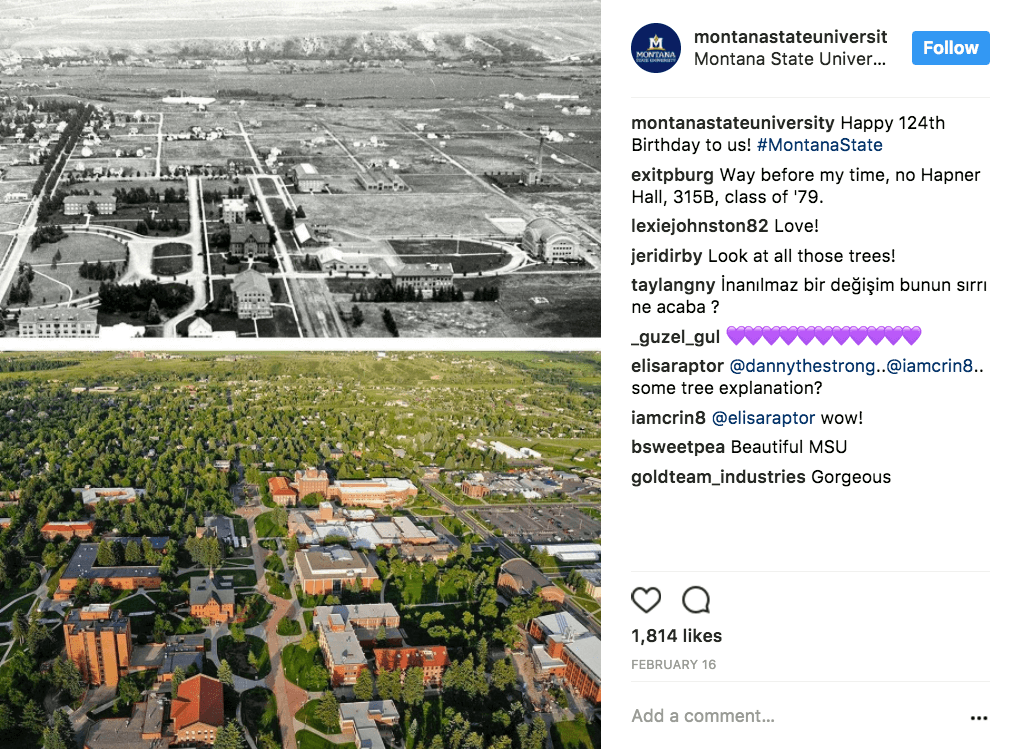
4. Recognize accomplishments
You can always create great engagement by recognizing the hard work and accomplishments of current students. Not only will you give much-deserved recognition, but you help comfort alumni that their school is just as good as they remember. The post below by Haverford College netted them a gaudy 7.6% engagement on Facebook.
Similarly, awards for the school and alumni as big winners in engagement. This post by Miami University about Oxford, Ohio, being named best college town in the nation earned 14.5% engagement–and 5,500 likes. Take advantage of community pride!
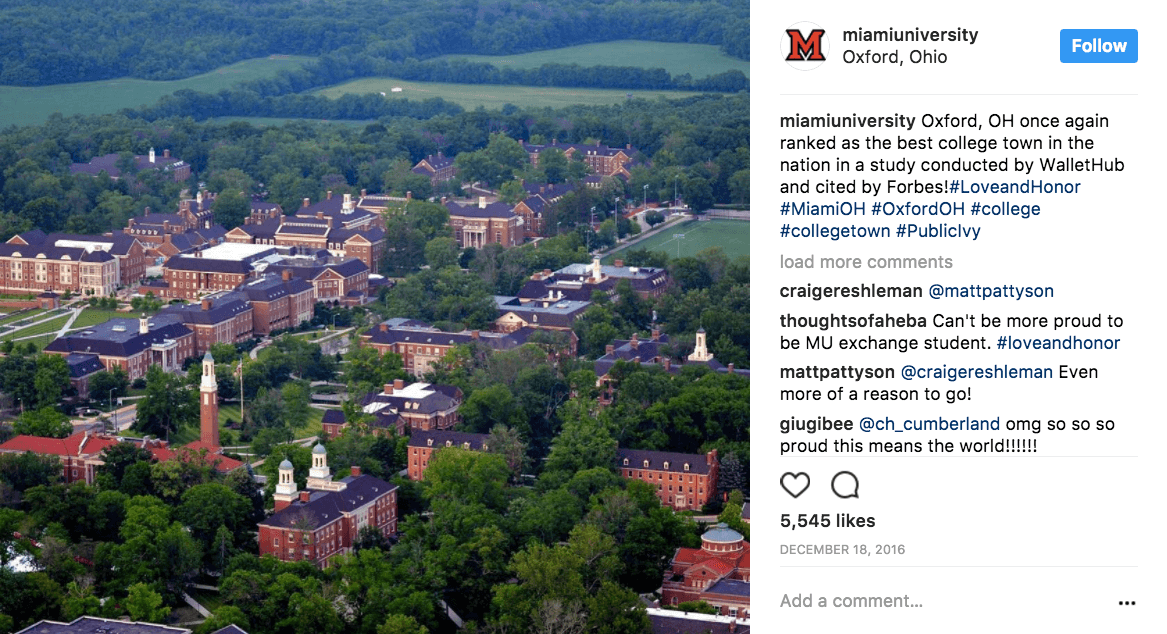
5. Social media is an all-season activity
Marking the passing of seasons is a great way to acknowledge current events while giving alumni an opportunity to think back on their own time on campus. Every campus has the ideal spot for a late summer sunset, a leaf-covered walkway in autumn, the perfect vista for snow, or a grove of trees with glorious blossoms in the spring. Each of these will evoke memories and nostalgia.
When snow hit Portland, Oregon, in January 2017, Lewis and Clark College took advantage of great photos of favorite locations, earning a whopping 23.6% engagement on this post.

6. Use campus landmarks
Even if you don’t have notable weather, you can always create high engagement by posting photos of campus. Across all regions and audiences, iconic campus photos are a simple and effective way to connect with followers.
In the example below, Notre Dame captured a rainbow over the Golden Dome for 9.4% engagement on Instagram, and 7.2% on Facebook.
These types of posts can be shared multiple times and across platforms for greater effect. They should be the foundation of your image-based posting strategy.
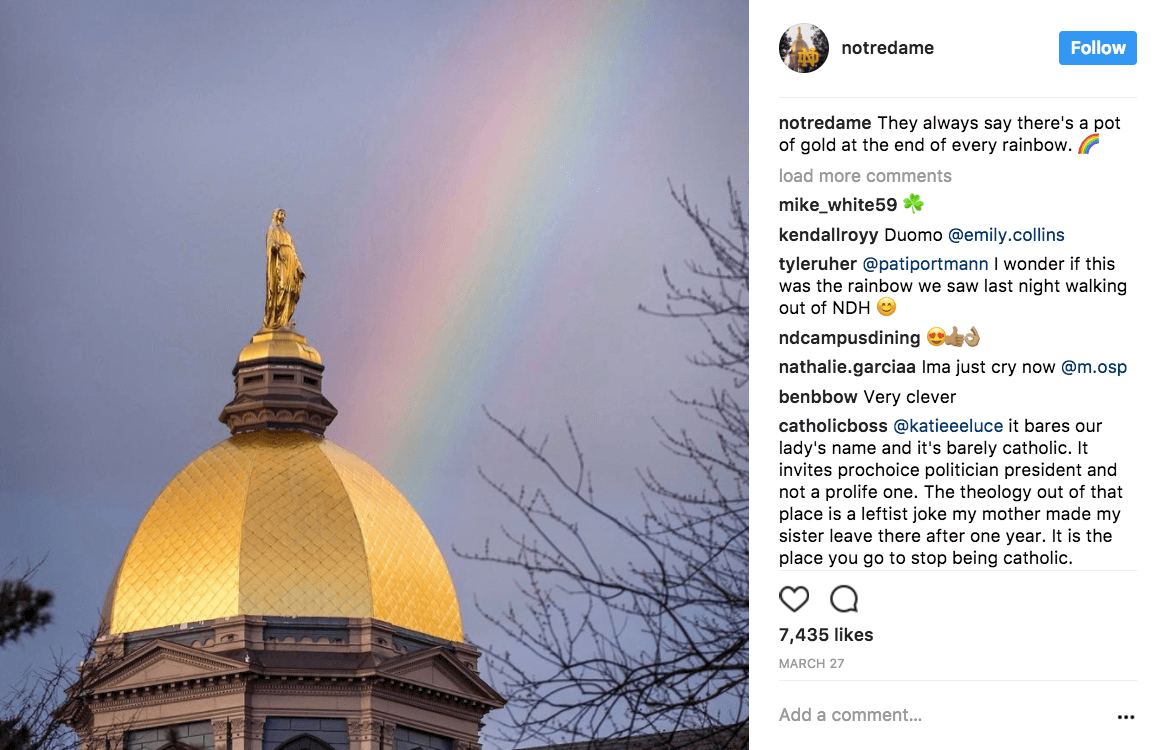
7. It starts with Instagram
If your goal is audience engagement, keep (or start) using Instagram. Without question, Instagram is an engagement winner in higher education. It’s not a coincidence that many of the examples in this blog are Instagram posts.
The past two years, Rival IQ and Up&Up have partnered to analyze the social media results for hundreds of higher ed institutions. We have captured this analysis in our annual Higher Ed Social Media Engagement Report.
In 2017, the average higher ed post on Instagram delivered 3.6% engagement. During the same time, corporate social media efforts saw only 1.7%.
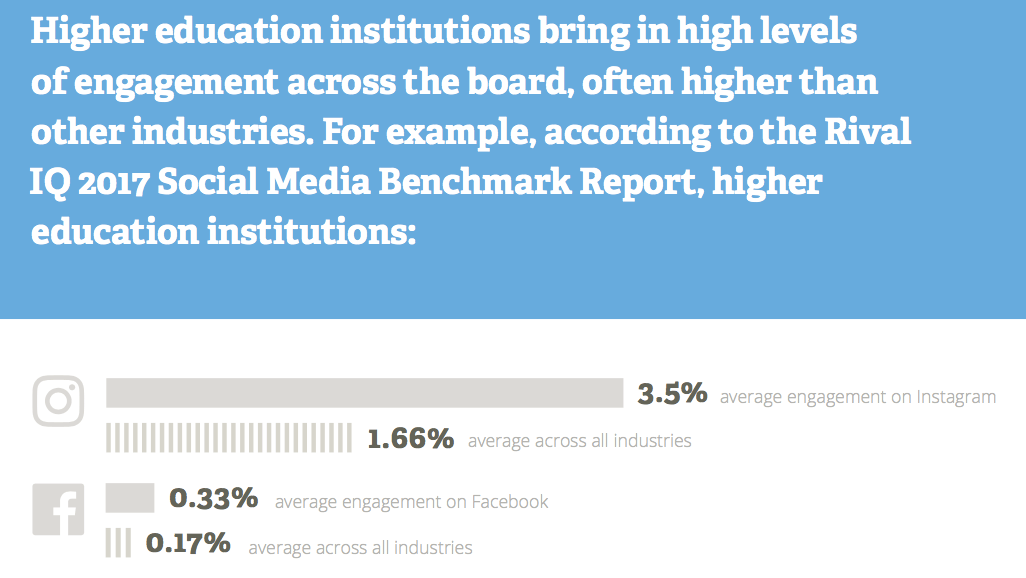
8. Sports, sports, sports
Another obvious one, but noting results for your teams, athletes, and fans is a terrific way to build engagement across your audiences. (Admittedly, it helps to post about successful teams, but that isn’t in your control.)
The post below by Whitman College on the success of their Men’s and Women’s basketball teams earned them a 13.2% engagement rate and a spot in their top 10 most engaging posts for the 2016/2017 academic year.
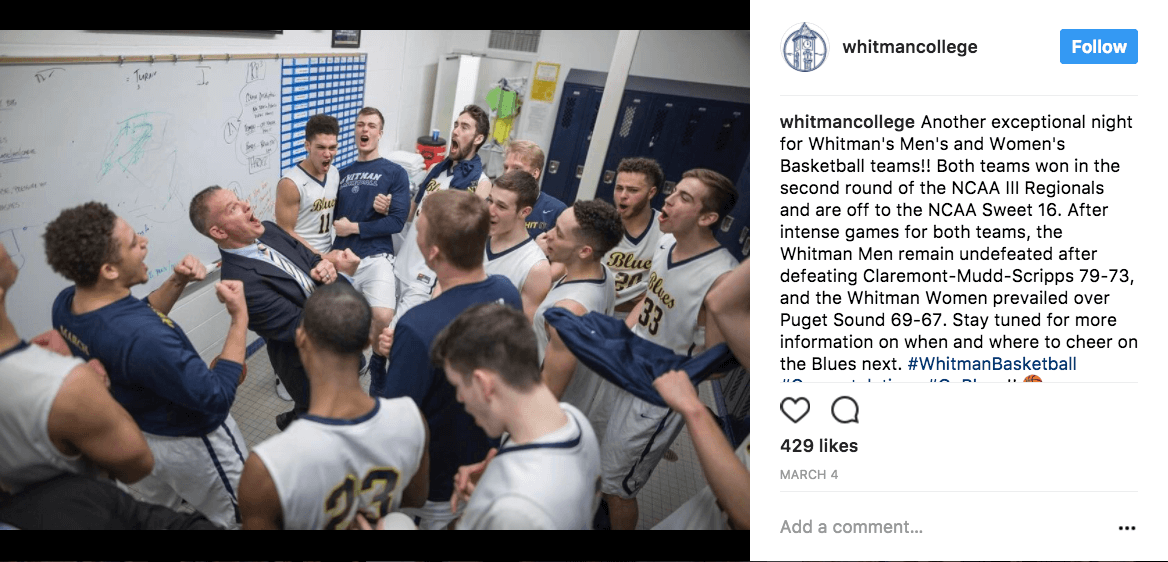
9. Mark transitions
It’s too obvious to mention posting about commencement. However, I do think it is important to think about *why* commencement is important. It represents many of the topics we’ve already covered: tradition, seasonality, community, emotion, etc.
Another example is the emotional time of freshmen arriving on campus in the fall. Your campus likely has a number of other events that meet the same criteria yet are less well established. Identifying those and posting about them will yield dividends.
In their most engaging post of the 2016/2017 school year, Georgetown marked the holiday period and saw an astonishing 18.4% engagement and nearly 6,200 likes.
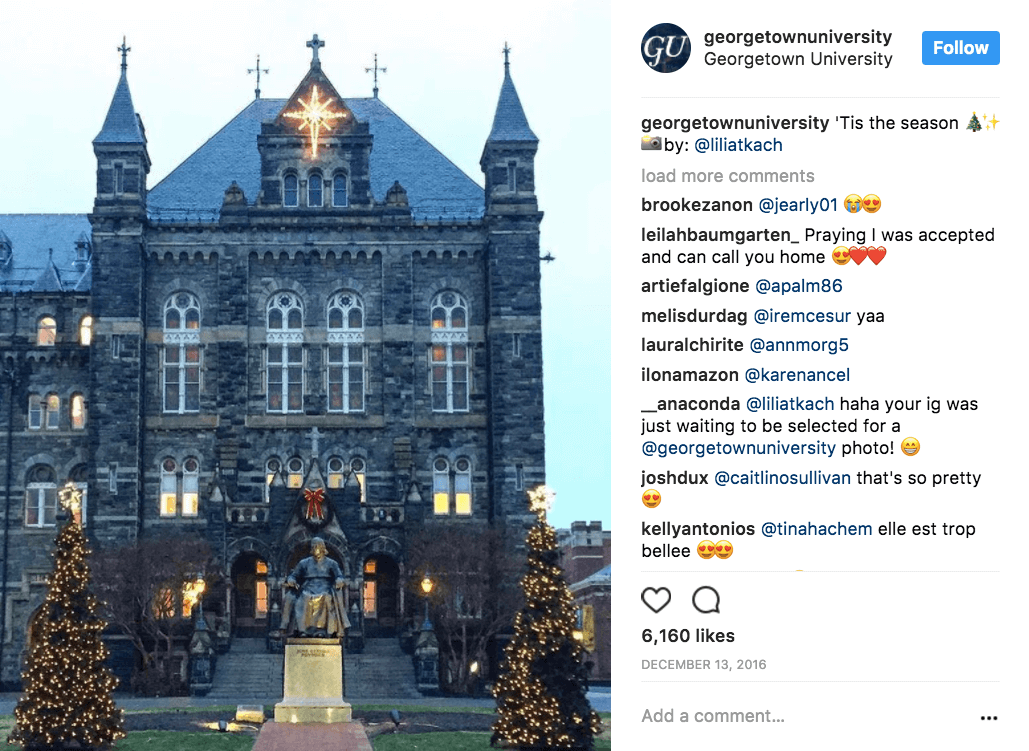
10. Create your own thing
Much of this list is about leveraging the innate emotional appeal of your campus and community, but plenty of room exists for you to stamp some of your own personality on your school’s social media presence.
One of my favorites is the way Stanford’s social media wishes goodnight to various locations on campus. The post below–wishing good night to the Dish, a radio telescope–is an example. From over 2,200 social posts by Stanford in the 2016/2017 academic year, ‘goodnight’ posts landed three posts in the top 21.
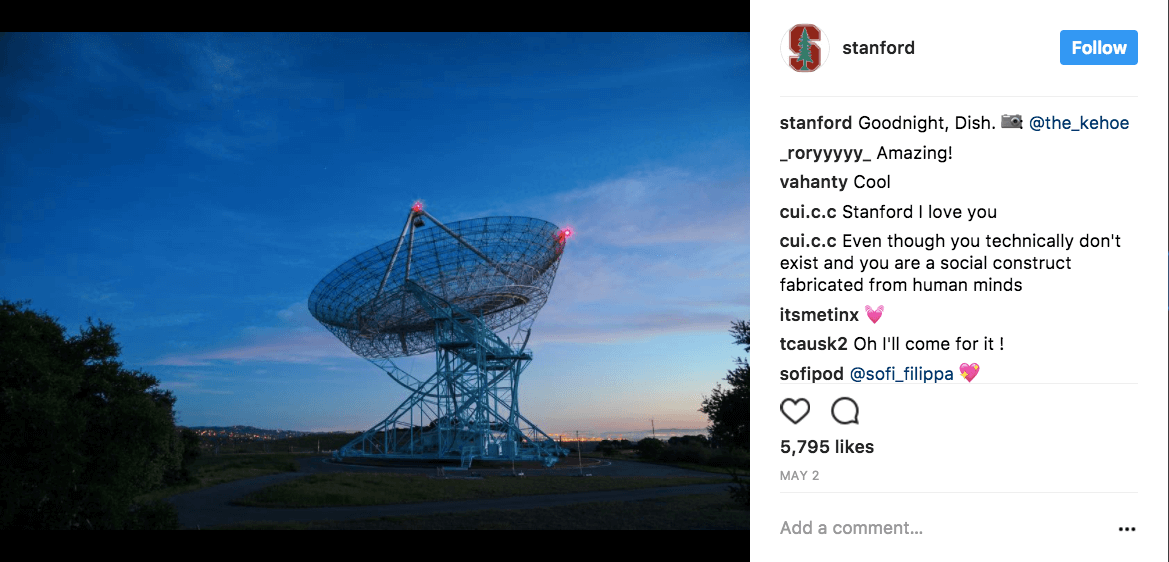
I challenge you to come up with something similar for your own community that effectively captures your campus vibe. With a little luck, you might create your own tradition.
11. Justify social internally
Look, if the Big Ten gets 14 schools, then my top ten list gets 11 points.
The previous items have been about your relationship with your social audience, but there is another audience that needs attention: your management.
All of us, no matter our positions, need to justify our efforts regularly. It is easy to say that social media cannot be tracked, or that the ROI of your efforts are impossible to quantify. Do not fall into that trap. Regularly reporting on your goals is never a bad idea, and helps show your value, explain the need for incremental budget, or define your influence.
Rival IQ can uncover your social benchmarks relative to your competitors so you can start tracking your efforts on social media. Start your free trial and decide for yourself.
